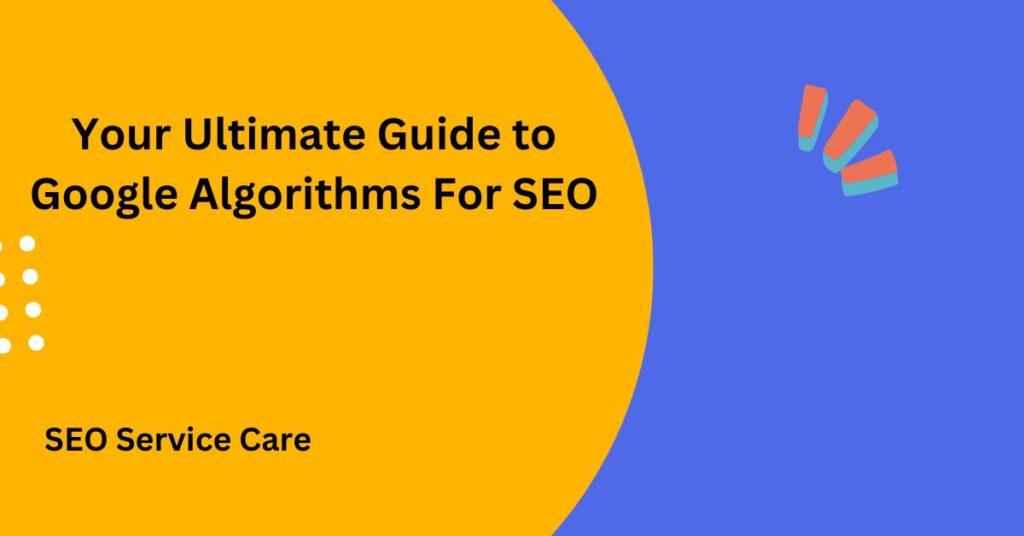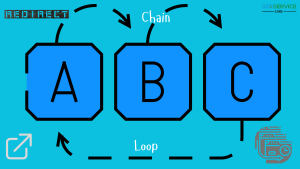Understanding Google’s algorithms is fundamental for achieving high search engine rankings, driving organic traffic, and increasing sales. This guide will demystify Google’s complex algorithms and equip you with actionable strategies for optimizing your website’s SEO.
Understanding Google Algorithms for SEO
Understanding Google algorithms means knowing the rules and calculations Google uses to decide which web pages show up in search results. Google often updates these algorithms to make searches better. They look at things like how relevant a page is, the quality of the content, how good the user experience is, and how trustworthy the site is. Keeping up with these changes and improving your website to match them can help your site rank higher and be seen by more people.
Importance of Google Algorithms for SEO
Google algorithms play a critical role in SEO (Search Engine Optimization) for several reasons:
-
Search Engine Rankings: Algorithms determine how web pages are ranked in search engine results pages (SERPs). Understanding algorithm updates helps SEO professionals optimize their websites to improve visibility and rankings.
-
Relevance and Quality: Algorithms prioritize content that is relevant to user queries and of high quality. SEO efforts align with these priorities to ensure content meets user expectations and search engine standards.
-
User Experience: Algorithms consider factors like page load speed, mobile-friendliness, and usability, influencing rankings to enhance the overall user experience.
-
Competition: SEO practitioners monitor algorithm changes to stay ahead of competitors, adapting strategies to maintain or improve rankings amidst evolving search engine requirements.
-
Traffic and Conversions: Higher rankings result in increased organic traffic, leading to more conversions and business growth opportunities.
-
Algorithm Updates: Regular updates (like Panda, Penguin, and BERT) refine how search engines interpret and rank content, requiring ongoing SEO adaptation and optimization.
Understanding and aligning with Google algorithms are fundamental to successful SEO strategies. They ensure websites meet search engine criteria and deliver valuable content to users.
Key Google Algorithms for SEO Updates
Google’s algorithm updates significantly influence the ranking and display of search results. Here are some key updates that have had significant impacts over the years:
1. Panda:
Initially rolled out in February 2011, Panda aimed to lower the rank of low-quality sites with thin content or poor user experience. It emphasized the importance of high-quality content and penalize sites with duplicate, plagiarized, or shallow content.
2. Penguin:
Launched in April 2012, Penguin targeted sites that violated Google’s Webmaster Guidelines using black-hat SEO techniques such as keyword stuffing, cloaking, or participating in link schemes. It aimed to improve the quality of search results by penalizing manipulative practices.
3. Hummingbird:
Introduced in August 2013, Hummingbird aimed to provide more relevant search results by better understanding the intent behind the queries rather than just focusing on individual keywords. It improved Google’s ability to handle conversational search queries and context.
4. Mobilegeddon:
Released in April 2015, this update prioritized mobile-friendly websites in mobile search results. By favoring sites optimized for mobile devices in terms of design and performance, it aimed to improve the user experience.
5. RankBrain:
RankBrain, a machine-learning artificial intelligence system, was announced in October 2015 and assisted in processing search results. It interprets complex, ambiguous, or unique queries that traditional algorithms might need help understanding and contributes to determining the ranking of search results.
6. Medic Update:
This broad core algorithm update, rolled out in August 2018, primarily impacted health and wellness websites, although its effects were felt across various niches. It emphasized the content’s expertise, authority, and trustworthiness (E-A-T).
7. BERT:
In October 2019, Google introduced BERT, an acronym for Bidirectional Encoder Representations from Transformers, to enhance language understanding in search queries. It helps Google better understand the context of words in searches, particularly for longer, more conversational queries.
8. Core Updates (Ongoing):
Google regularly rolls out broad-core algorithm updates to improve how it assesses and ranks content. These updates aim to refine search result quality by adjusting various ranking factors, including content relevance, quality, and expertise.
These updates reflect Google’s ongoing efforts to enhance its search results’ relevance, quality, and user experience, shaping web admins’ and digital marketers’ SEO strategies and practices. For businesses looking to adapt to these changes and improve their online presence, our technical SEO services can provide the necessary expertise and support.
On-Page SEO Techniques
On-page SEO is directly implementing optimization efforts on a website to enhance its search engine rankings and visibility. Here are some key on-page SEO techniques:
-
Keyword Optimization
-
Content Quality
-
Meta Tags
-
URL Structure
-
Headers (H1, H2, etc.)
-
Image Optimization
-
Internal Linking
-
Page Loading Speed
-
Mobile-Friendliness
-
User Experience (UX)
Using these on-page SEO techniques can help more people see your website, bring in more visitors, and make users happier. It’s important to keep an eye on your site and make changes based on data and good SEO practices for lasting success.
For expert help in optimizing your online store, check out our ecommerce SEO services. Also, You can contact us online or call +8801581-646452 today to speak with one of our experts directly!
Optimizing Content for Panda
To optimize content for Google’s Panda algorithm update,
-
Focus on creating high-quality, unique content that provides value to users.
-
Avoid duplicate or thin content.
-
Ensure the content is well-researched, authoritative, and comprehensive.
-
Use proper grammar, spelling, and formatting.
-
Where applicable, incorporate multimedia elements such as images and videos.
-
Monitor user engagement metrics (bounce rate, time on page) and adjust content accordingly.
Maintaining Quality Backlinks for Penguin
To maintain quality backlinks and comply with Google’s Penguin algorithm,
-
Focus on Natural Link Building: Acquire links organically through valuable content, partnerships, and relationships rather than artificial methods.
-
Relevant and Authoritative Sources: Seek links from reputable websites pertinent to your niche or industry, emphasizing quality over quantity.
-
Diverse Link Profile: Aim for a diverse range of anchor texts and sources to avoid appearing manipulative.
-
Monitor and Disavow: Regularly audit backlinks using tools like Google Search Console to identify and disavow toxic or spammy links that could harm your site’s ranking.
-
Quality Content: Continuously produce high-quality content that naturally attracts backlinks from authoritative sites.
-
Avoid Link Schemes: Avoid any schemes that aim to manipulate PageRank, such as buying links or participating in link farms.
-
Social Signals: Leverage social media platforms to amplify content visibility and attract natural backlinks.
Adhering to these practices can help ensure that your backlink profile remains strong and compliant with Google’s guidelines, thereby avoiding penalties from the Penguin algorithm.
Enhancing Semantic Search with Hummingbird
To enhance semantic search with Google’s Hummingbird algorithm, focus on the following strategies:
-
Use Natural Language: Create content that reflects how people naturally speak and ask questions. Hummingbird aims to understand the context and intent behind queries, so using conversational language helps.
-
Answer Questions Directly: Structure your content to provide clear and direct answers to common questions related to your topic. This aligns with Hummingbird’s goal of satisfying user queries comprehensively.
-
Long-Tail Keywords: Incorporate long-tail keywords and phrases that reflect specific user intents and queries. These can match more closely with Hummingbird’s semantic search capabilities.
-
Topic Clusters: Organize your content into topic clusters or themes. This approach helps Google understand the breadth and depth of your content on related topics, improving your chances of ranking for semantic search queries.
-
Structured Data Markup: Use structured data (schema markup) to provide search engines with additional context about your content. This can improve your content’s appearance in search results and increase its visibility for relevant queries.
-
Improve User Experience: Focus on delivering a seamless user experience with simple navigation, rapid loading times, and mobile optimization. A positive user experience can indirectly improve your search rankings by increasing engagement metrics.
-
Optimize for Voice Search: Since Hummingbird supports voice search queries, optimize your content to be voice-search-friendly. This includes using natural language, answering common queries, and ensuring compatibility with voice-enabled devices.
-
Monitor and Adapt: Regularly monitor your site analytics and search performance to identify opportunities for improvement. Adapt your content strategy based on user behavior and emerging semantic search trends.
By implementing these strategies, you can effectively enhance your website’s alignment with Google’s Hummingbird algorithm, improving its visibility and relevance in semantic search results.
Leveraging User Intent for RankBrain
To leverage user intent for RankBrain, which is Google’s machine-learning AI system that helps process search results, follow these strategies:
-
Understand User Intent
-
Optimize Content for Relevance
-
Use Natural Language
-
Long-Tail Keywords
-
Focus on User Experience
-
Diversify Content Formats
-
Monitor and Adapt
-
Semantic Search Optimization
By effectively understanding and meeting user intent, you can improve your content’s relevance and visibility in search results, leveraging Google’s RankBrain algorithm to your advantage.
Implementing Natural Language Processing with BERT
Implementing Natural Language Processing (NLP) with BERT (Bidirectional Encoder Representations from Transformers) involves leveraging this state-of-the-art model for various applications. Here’s how you can effectively implement NLP using BERT:
-
Text Classification
-
Named Entity Recognition (NER)
-
Question Answering
-
Text Generation
-
Semantic Search
-
Conversational AI
-
Multilingual Applications
-
BERT-Based Models
Implementation Steps:
-
Pre-processing: Tokenize and prepare your text data in a format suitable for BERT input.
-
Fine-tuning: Fine-tune BERT on task-specific datasets to adapt the model parameters to your NLP task.
-
Evaluation: Evaluate the performance of the fine-tuned BERT model on validation or test datasets using metrics relevant to your task (e.g., accuracy, F1 score).
-
Deployment: Ensure you meet scalability and performance considerations by integrating the fine-tuned BERT model into your application or system.
By effectively implementing BERT in your NLP applications, you can leverage its powerful capabilities for understanding and processing natural language, improving accuracy and performance across various tasks.
Off-Page SEO Strategies
Off-page SEO refers to activities done outside your website to improve its search engine rankings and authority. Here are some effective off-page SEO strategies:
-
Link Building: Acquire high-quality backlinks from authoritative and relevant websites. Focus on natural link-building through guest blogging, partnerships, and outreach campaigns.
-
Social Media Engagement: Build a strong presence on social media platforms to increase brand visibility and drive traffic to your website. Encourage sharing and engagement with your content.
-
Online Reputation Management: Monitor and manage your online reputation by responding to reviews, addressing customer feedback, and maintaining a positive brand image across the web. For more tips on enhancing your brand’s image, check out our guide on improve your business reputation.
-
Influencer Outreach: Collaborate with influencers in your industry to reach a wider audience and gain credibility through endorsements and mentions.
-
Local SEO: Optimize your presence on local business directories, Google My Business, and other local listings. Encourage reviews and citations from local sources. For more details on how to effectively enhance your local visibility, check out our guide on local SEO best practices.
-
Content Marketing: Create valuable, shareable content that attracts natural links and social shares. This includes blog posts, infographics, videos, and eBooks.
-
Forum and Community Participation: Engage in relevant forums, Q&A sites, and online communities to build relationships, establish expertise, and drive traffic back to your site.
-
Brand Mentions: Monitor and capitalize on brand mentions across the web. Encourage mentions via PR efforts, partnerships, and content creation.
-
Guest Posting: Contribute guest posts to reputable websites and blogs in your niche. This builds backlinks, establishes your authority, and expands your audience. For more details, check out our premium guest post service.
-
Competitive Analysis: Examine your competitors’ backlink profiles and strategies to identify opportunities for improvement and differentiation.
By effectively implementing these off-page SEO strategies, you can enhance your website’s authority, visibility, and search engine rankings. Regular monitoring and adjustments based on analytics and industry trends are critical for sustained success.
Future Trends in Google Algorithms for SEO
Predicting future trends in Google algorithms involves considering ongoing technological developments, user behavior, and Google’s objectives. Here are some potential future trends:
-
Artificial Intelligence and Machine Learning: Continued integration of AI and machine learning (like BERT and RankBrain) to better understand and interpret user intent, context, and content relevance.
-
Natural Language Processing (NLP): Further advancements in NLP will improve semantic search capabilities, allowing Google to understand and process natural language queries more accurately.
-
User Experience (UX) Signals: There has been increased emphasis on UX signals such as page loading speed, mobile friendliness, and overall user engagement metrics (dwell time, bounce rate) as ranking factors.
-
E-A-T (Expertise, Authoritativeness, Trustworthiness): Continued focus on content quality and credibility, particularly for YMYL (Your Money or Your Life) topics, health, finance, and legal sectors.
-
Mobile-First Indexing: Given the increasing use of mobile devices for internet access, fully adopt mobile-first indexing as the primary method of evaluating and ranking websites.
-
Core Web Vitals: Ongoing refinement and integration of Core Web Vitals metrics (such as Largest Contentful Paint, First Input Delay, and Cumulative Layout Shift) are essential page experience ranking factors.
-
Privacy and Security: Google may prioritize websites that prioritize user privacy and data security, potentially incorporating these factors more prominently into its algorithms.
-
Structured Data and Rich Results: Enhanced use of structured data markup (schema.org) to generate rich results in search, providing more informative and visually appealing SERP features.
-
Voice Search and Conversational AI: Optimization for voice search and the adoption of conversational AI to handle complex queries and provide more personalized search results.
-
Algorithm Transparency and Updates: Google may continue to improve transparency around algorithm updates and provide more guidance to web admins to help them adapt and optimize their sites accordingly.
These trends show that search engines are becoming smarter and more focused on giving users a better experience with high-quality and relevant content.
To stay visible in search results, it’s important to keep up with these changes and adjust SEO strategies to match. This will help ensure that websites remain easy to find and useful to users in the future.
Preparing for Future Algorithm Changes
Preparing for future algorithm changes requires a proactive and adaptive approach to SEO. Here are steps to effectively prepare:
-
Stay Informed: Keep up-to-date with industry news, Google announcements, and algorithm updates. Follow reliable sources such as Google’s Webmaster Central Blog, industry forums, and reputable SEO publications.
-
Understand Current Algorithms: Gain a deep understanding of Google’s current algorithms (e.g., BERT, RankBrain, Core Web Vitals) and their impact on search rankings. Monitor changes in ranking factors and adjust strategies accordingly.
-
Focus on Quality Content: Prioritize creating high-quality, valuable content that meets user intent and provides a positive user experience. Emphasize originality, relevance, and depth in your content strategy.
-
User Experience (UX) Optimization: Improve site performance, usability, and accessibility. To enhance UX, consider Core Web Vitals metrics (loading speed, interactivity, and visual stability) and mobile-friendliness.
-
Build Quality Backlinks: Focus on acquiring natural and authoritative backlinks from relevant sources. Avoid link schemes, and prioritize relationships with reputable websites in your industry.
-
Optimize for Mobile and Voice Search: Ensure your website is optimized for mobile devices and queries. Adapt content to suit natural language queries and conversational search patterns.
-
Utilize Structured Data: Implement structured data markup (schema.org) to enhance your site’s appearance in search results and enable rich snippets. This can improve click-through rates and visibility.
-
Monitor Performance Metrics: Regularly analyze key performance indicators (KPIs) such as traffic, rankings, engagement metrics (dwell time, bounce rate), and conversion rates. Identify trends and areas for improvement.
-
Adaptability and Flexibility: SEO is dynamic, so be prepared to adapt strategies based on algorithm updates and changes in search behavior. Test and iterate tactics to find what works best for your site.
-
Diversify Traffic Sources: Reduce dependency on organic search by diversifying traffic sources. Invest in other channels like social media, email marketing, and paid advertising to maintain a steady traffic flow.
By taking a proactive approach to SEO, focusing on user-centric strategies, and staying informed about upcoming trends and algorithm changes, your website can withstand future updates and improve its search engine visibility and performance over time.
Conclusion:
Navigating Google’s algorithms requires understanding their intricacies and implementing effective SEO strategies. You can enhance your website’s ranking, organic traffic, and sales by continually adapting to updates and focusing on high-quality, user-centric practices.
FAQ:
What is the Google algorithm for SEO?
Google uses a set of rules and calculations known as the Google algorithm for SEO to determine the ranking of web pages in search engine results.
It evaluates various factors, such as relevance, quality of content, user experience, and authority, to deliver the most relevant and valuable results to users based on their search queries.
Understanding and optimizing these factors is crucial for improving search engine rankings and visibility.
Which algorithm is used in SEO?
Google and other search engines use various SEO algorithms to rank web pages. Google’s main system for deciding which websites show up first in search results uses many smaller systems.
These systems look at different things like how useful the content is, the quality of the website, the links from other websites, and how easy the site is to use.
Some of these smaller systems are named PageRank, Panda, Penguin, Hummingbird, RankBrain, and BERT. Google also regularly updates these systems to make sure they do a better job of ranking websites.
How often does Google update its algorithms?
Google updates its search algorithms thousands of times each year. These updates can be small changes or big changes that affect how websites show up in search results.
Big changes happen a few times a year to make sure the search results are better, more useful, and easier for people to use.
Are backlinks still important for SEO?
Yes, backlinks remain a crucial factor in SEO. They act as endorsements from other websites, signaling to search engines that your site is credible and valuable.
Quality backlinks from reputable sources can significantly improve your site’s authority and rankings in search engine results.
How can AI and machine learning impact SEO?
AI and machine learning are changing how we do SEO by making websites better for users. These smart technologies help make content more relevant and improve how search engines work.
AI can look at a lot of information to guess what people want, make content better, and personalize search results, so users find what they need more easily and have a better experience.
What role does content quality play in SEO?
Content quality is pivotal in SEO because it directly impacts how your website performs in search engine results:
-
Relevance: High-quality content is tailored to meet users’ search intent, ensuring it effectively addresses their queries.
-
Visibility: Search engines prioritize well-written, informative, and relevant content, making it more likely to appear higher in search results.
-
User Engagement: Quality content encourages users to stay on your site longer, reducing bounce rates and increasing the likelihood of conversions.
-
Authority Building: In their industry, people perceive websites with consistently high-quality content as authoritative, which attracts more backlinks and enhances overall SEO efforts.
Additionally, AI-driven insights help marketers make data-driven decisions, adapt strategies quickly to algorithm changes, and improve overall website performance in search engine rankings.






